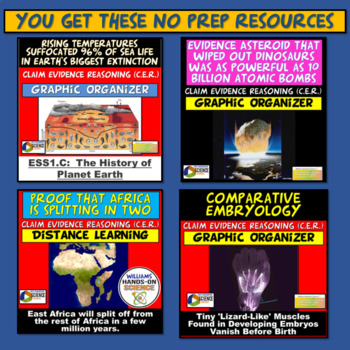Evolution Claim Evidence Reasoning CER Bundle with Graphic Organizers
- Zip
- Google Apps™

What educators are saying
Products in this Bundle (16)
showing 1-5 of 16 products
Description
Students learn about various current events and discoveries in Evolution through Claim Evidence Reasoning. You get 10+, 30-40 minute NO PREP resources that are great for English Language Arts, Sub Plans, reinforcing content, application of content to the real world and the NGSS Science and Engineering Practice of “Engaging in Argument from Evidence.”
This is great for getting your students to explain phenomena in a meaningful way and it allows you as the instructor to adequately assess their understanding of concepts. The students figure out what the "Claim" is in the article, they then use data that supports the claim in the "Evidence" section, draw visual evidence and then explain why the evidence supports the claim in the "Reasoning" section.
You also get 7 different generic templates used for any current events that apply to your content. Any time I see an interesting article that applies to what we are learning, I use these as my Go-To templates!
These are great for emergency sub plans and integrating into lessons so that your students can put content into context!
You get the following:
-7 CER Graphic Organizer Templates
-Over 10 Evolution articles (and growing) to print hard copies and/or web addresses for reading off of the computer
-CER Anchor Charts
-CER Teacher Tips
If you want a larger variety of science topics AND save money, take a look at my Claim Evidence Reasoning Mega-Bundle
The following Titles are included:
Oldest Evidence of Life Found
The first life on Earth depended on a deadly poisonous gas, study suggests
Why are Tigers Orange?
Newly named human species may be the direct ancestor of modern humans
Rising Temperatures Suffocated 96 Percent of Sea Life in Earth's Biggest Extinction
1.7-Billion-Year-Old Chunk of North America Found Sticking to Australia
Oldest human DNA from Africa
Mysterious New Form of DNA
Early Humans Probably Didn't Evolve from a Single Population
Tiny 'Lizard-Like' Muscles Found in Developing Embryos
Africa is Splitting: Here’s Why
Here's More Proof Earth Is in Its 6th Mass Extinction
Climate Change May Change Ecosystems
NGSS Standards:
LS4.A: Evidence of Common Ancestry and Diversity
• The collection of fossils and their placement in chronological order (e.g., through the location of the sedimentary layers in which they are found or through radioactive dating) is known as the fossil record. It documents the existence, diversity, extinction, and change of many life forms throughout the history of life on Earth. (MS-LS4-1)
• Anatomical similarities and differences between various organisms living today and between them and organisms in the fossil record, enable the reconstruction of evolutionary history and the inference of lines of evolutionary descent. (MS-LS4-2)
• Comparison of the embryological development of different species also reveals similarities that show relationships not evident in the fully-formed anatomy. (MS-LS4-3)
LS4.B: Natural Selection
• Natural selection leads to the predominance of certain traits in a population, and the suppression of others. (MS-LS4-4)
LS4.C: Adaptation
• Adaptation by natural selection acting over generations is one important process by which species change over time in response to changes in environmental conditions. Traits that support successful survival and reproduction in the new environment become more common; those that do not become less common. Thus, the distribution of traits in a population changes. (MS-LS4-6)
LS4.A: Evidence of Common Ancestry and Diversity
• Genetic information provides evidence of evolution. DNA sequences vary among species, but there are many overlaps; in fact, the ongoing branching that produces multiple lines of descent can be inferred by comparing the DNA sequences of different organisms. Such information is also derivable from the similarities and differences in amino acid sequences and from anatomical and embryological evidence. (HS-LS4-1)
LS4.B: Natural Selection
• Natural selection occurs only if there is both (1) variation in the genetic information between organisms in a population and (2) variation in the expression of that genetic information—that is, trait variation—that leads to differences in performance among individuals. (HS-LS4-2), (HS-LS4-3)
• The traits that positively affect survival are more likely to be reproduced, and thus are more common in the population. (HS-LS4-3)
LS4.C: Adaptation
• Evolution is a consequence of the interaction of four factors: (1) the potential for a species to increase in number, (2) the genetic variation of individuals in a species due to mutation and sexual reproduction, (3) competition for an environment’s limited supply of the resources that individuals need in order to survive and reproduce, and (4) the ensuing proliferation of those organisms that are better able to survive and reproduce in that environment. (HS-LS4-2)
• Natural selection leads to adaptation, that is, to a population dominated by organisms that are anatomically, behaviorally, and physiologically well suited to survive and reproduce in a specific environment. That is, the differential survival and reproduction of organisms in a population that have an advantageous heritable trait leads to an increase in the proportion of individuals in future generations that have the trait and to a decrease in the proportion of individuals that do not. (HS-LS4-3), (HS-LS4-4)
• Adaptation also means that the distribution of traits in a population can change when conditions change. (HS-LS4-3)
• Changes in the physical environment, whether naturally occurring or human induced, have thus contributed to the expansion of some species, the emergence of new distinct species as populations diverge under different conditions, and the decline–and sometimes the extinction–of some species. (HS-LS4-5)
• Species become extinct because they can no longer survive and reproduce in their altered environment. If members cannot adjust to change that is too fast or drastic, the opportunity for the species’ evolution is lost. (HS-LS4-5)
• TERMS OF USE
• • All rights reserved by Williams Hands On Science, Inc.
• • This product is to be used by the original purchaser only.
• • Intended for classroom and personal use only.
• • Copying for more than one teacher, classroom, department, school, or school system is prohibited.
• • This product may not be distributed or displayed digitally for public view.
• • Failure to comply is a copyright infringement and a violation of the Digital Millennium Copyright Act (DMCA).
• If there are any errors or questions, please contact me through TpT or email me at:
• williamshandsonscience@gmail.com
• Thank you for taking a look!
• Please follow me on TpT for new products and check me out on Instagram for my products in action!
• https://www.instagram.com/williams_hands_on_science/
Related Products
⭐ Claim Evidence Reasoning (CER) North Korea Missile Launch
⭐ Claim Evidence Reasoning (CER) The Physics of Car Crashes
⭐ Claim Evidence Reasoning (CER): Autumn Equinox Can Fall on Different Days
⭐ Claim Evidence Reasoning California Mudslides (Current Event and Sub Plan)
⭐ Claim Evidence Reasoning Growing Bundle
⭐ Claim Evidence Reasoning Plate Tectonics Pangaea Article and Graphic Organizer
⭐ Claim Evidence Reasoning: Government Report on Human Caused Climate Change
⭐ Hurricane Harvey Claim Evidence Reasoning Graphic Organizer
⭐ Hurricane Harvey Claim Evidence Reasoning Graphic Organizer (NatGeo Article)
⭐ Hurricane Irma CER (Claim Evidence Reasoning) Graphic Organizer
⭐ NGSS Black Holes & Galaxies Claim Evidence Reasoning Graphic Organizer
⭐ NGSS Claim Evidence Reasoning (CER) Big Bang Graphic Organizer
⭐ NGSS Claim Evidence Reasoning (CER) High Frequency Sound Waves
⭐ NGSS Claim Evidence Reasoning (CER) Kilauea Volcano Eruption Earthquakes
⭐ NGSS Claim Evidence Reasoning (CER) Oldest Evidence of Life on Land Found
⭐ NGSS Claim Evidence Reasoning The Mysterious Planet Nine Solar System Astronomy
⭐ NGSS Claim Evidence Reasoning (CER) Water Found on Mars
⭐ NGSS Climate Change & Extreme Weather Claim Evidence Reasoning
⭐ NGSS Common Core Claim Evidence Reasoning (CER) Graphic Organizers
⭐ NGSS Current Event Claim Evidence Reasoning California Wildfires
⭐ NGSS Current Event Claim Evidence Reasoning Climate Change May Change Ecosystems
⭐ NGSS Expanding Universe Claim Evidence Reasoning Graphic Organizer
⭐ NGSS Mysterious New Form of DNA Claim Evidence Reasoning Graphic Organizer





